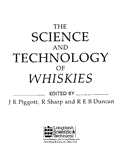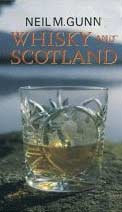

| Page: next | |
| Scotch Whisky: Its past and present, David Daiches, 5th ed., 1983.
This was one of the first whisky books written for the whisky enthusiasts. It describes the whisky process, its history, its barons and the tasting of whiskies. It does not read as easily as some current whisky books, but contains a lot of information and the perception of D. Daiches of the whisky industry at the start of the boom of the 1970s when every company started to build new distillery. Will appeal to any whisky enthusiast whishing to understand the evolution of the whisky industry during these last 30 years. |
|
 |
The Science and Technology of Whiskies, J.G. Piggott, R Sharp and R.E.B. Duncan, Longman Scientific and & Technical, ed. 1989.
Remark: This book is written by scientists for scientist. For a more "gentle" book, see the book below. Part of my academic career was dealing with Plant Biochemisty during my MSc. Scientific knowledges are a pre-requisite to read and understand this book and do not expect to read more than a dozen pages per hour. After having said that, the work of Piggott et al., is impressive and a well of information. Altough it is more than 15 years old, the content still feels up-to-date. The topics covered go from Botany (barley structure) to engineering (bottling technology and distillery design and energy management), and also includes chemistry (chemistry of the flavours and maturation). It is the most detailed book on whisky techology that exists and highly recommended to anyone wishing to spend hours in understanding the science behind the whisky production. Rating: 5/5 (for scientists interested in whisky technology), 1/5 for the non-scientist whisky enthusiast. |
| Whisky: Technology, Production and Marketing by I. Russell, ed. 2003.
This is the most recent scientific work on whisky technology, production and marketing. For a scientific book, it is quite comprehensible for a non-scientific with clearly detailed sections and chapters. It is well conceived and provides most of the information to anyone interesting in acquiring knowledge about the details of whisky production. However, additional schemes and drawings would have helped to make it more clear. Noteworthy, "The Science and Technology" by Piggott et al. (see above) is more detailed. Rating: 4/5 |
|
| Wort, Worms & Washbacks: Memoirs from the stillhouse, John McDougall and Gavin D. Smith, The Angels' share, 2003. This book, the memoirs of a whisky man, McDougall, is a personal story and a mirror of the changes in the whisky industry between the 1960s and 1980s. McDougall moved quite a lot during his whisky carreer, with its ups and downs, and the book gives a real insight in the life of the industry, in the Speyside as well as in Islay or in the Lowlands (and some more). The book is entertaining as it is written with British humour. I enjoyed it quite a lot and would recommend it to anyone interested in the life of the whisky men during the 60s and the 80s. |
|
| 26 Malts: Some Joy Ride, Cyan books, 2005.
This book is an "exercise of style", between a writer and a designer, to put words and colours together and make whisky labels. Graphically, the book is superb with a modern, glossy, bright and original layout. This book covers the genesis of the labels for the new serie of 26 scotch whiskies for the Scotch Malt Whisky Society. It is also an indication on how remote the designer and the advertiser are from the product. The concept used for creating these labels is interesting and should be used more often. My major comment is the shortness of some texts comments in the label design, and the impression that some labels and contents were done in a hurry. |
|
| Scotch: The whisky of Scotland in Fact and Story by Sir Robert B. Lockhart, 7th Ed. Neil Wilson Publisher.
An excellent book about the scotch whisky industry. It is clearly written, very concise, but pleasant to read. It covers the history of the industry detailed a few years later by Dr R.B. Weir and R.B. Lockhart succeded in giving more informations about the whisky barons than Allen Andrews in his book, "The Whisky Barons". I was impressed by the amount of information resumed in only ~170 pages. Highly Recommended. |
|
| The Whisky Barons by Allen Andrews, Angels Share, ed. 2002.
Reprint of the 1977 work. Clear, concise, this book relates in details the life of Tom(as) Dewar and James Buchanan as well as the negotiations between Berry Bros & Rudd and the bootlegger in Nassau during the US prohibition. This last story is quite fascinating. The title is somewhat misleading, as the other whisky barons are just mentioned on the bottom of one page, such as James Stevenson (Johnnie Walker). I regret also the absence of references, but enjoyed the life that A. Andrews gave to the different protagonists. |
|
| The Scottish Whisky Distilleries: For the Whisky Enthusiast by Udo Misako, Paul Tebble ed. 2005.
The presentation of this book is very austere: all in B&W, a few schemes, no illustrations and the layout seems to come straight from a typewriter. So is it worth something? Yes! It is an impressive book gathering all the details you can think of concerning the distilleries, from the number of stills to the size of the washbacks, from the water source name to the distillation time for all the operating Scotch distilleries. Does also include information on mothballed and demolished distilleries. The amount of information is impressive and excellent value for your money, as long as you are interested in technical details. |
|
| A Double Scotch: How Chivas Regal and The Glenlivet Became Global Icons by F. Paul Pacult by John Wiley & Sons Inc, ed. 2005.
Written like a Holywood movie, it is a very enjoyable book to read about the two most famous scotch whisky brands in the US: Chivas Regal and The Glenlivet. Those two histories are described in details, but in a very fluid style, making it easy and pleasant to read. Sometimes it might be difficult to distinguish facts and stories, but that is okay. |
|
| It's a Bad Thing Whisky, Especially Bad Whisky by Edward Burns, ed. 1995.
Based on the journal article "It's a Bad Thing Whisky, Especially Bad " published in September 1892 in the journal North British Daily Mail, E. Burns did a careful investigation on whisky adulteration, shebeens and druggists practices during that period. It is well written, with many journal abstracts to illustrate his theory. However, its convictions are heavily based on the quality of the science at this period, which he has over-evaluated.. |
|
| The Distilleries of Campbeltown by David Stirk, ed. 2005.
The Rise and fall of the whisky capital of the world is written in the same epistolary style as Bad Whisky from E. Burns. The book in itself is relatively short (104 pages) and does describe Campbeltown during the 19th and beginning of the 20th Century through letters and journal articles from that period. David did a good work at picking up those references. There are some nice B&W photographs, but the "story line" is relatively thin and not so conclusive about the real reason for the fall of these distilleries. |
|
| Whisky Men by Gavin D. Smith, ed. 2005.
First published in 2005, the Whisky Men by Gavin D.Smith is an interesting book about the men working in the different sectors of the whisky production. Each sector of activity (e.g., distillation) are the story of one or more man. Although there are some inconsistencies in the text written by G.D. Smith, the stories are interesting and this book is nicely illustrated by old photographs. The layout is nice, pleasant and the style is easy to read. Rating: 4/5 |
|
| Scots on Scotch by Philip Hills, ed. 2002.
The work of Philip Hills is a compilation of "short stories" about Whisky written by Scots. Some stories are interesting (e.g., the history about cask and maturation) and some less (e.g. poems). The stories are of uneven quality. With the mix of topics reviewed, everyone will find something of Interest, but I would not recommend it as an introduction to the whisky world. The presentation is rather austere. Rating: 3/5 |
|
| Whisky Classified by David Wishart, ed. 2002.
With M. Jackson and J. Murray, whiskies are described and rated by their nose, taste, finish and balance. Sometimes, the comments are unformative (e.g. decent but quite rich) and thus will not help the buyer to select his whisky. D. Wishart replaces this jargon and rating and described the whiskies by their flavour profile. The range of whiskies is somewhat limited, but the approach interesting. Layout is clear and easy to read. Rating: 4/5. |
|
 |
Whisky and Scotland by Neil Miller Gunn. Souvenir Press, ed. 1977.
Neil Gunn became an exciseman in 1924 at Glen Mhor Distillery and left Customs and Excise after writing this book about Whisky and Scotland. Eventhough it was written in the 1930s, we have the impression it was writtend today. It is about Nationalism, the culture of whisky in Scotland and its history. Very enjoyable but difficult to find, I can ony recommend it. Rating: 5/5. |
| The history of the Distillers Company 1879-1939 by Ronald B. Weir, ed. 1995 Following his thesis work, the History of the Malt Distillers' Association of Scotland, Ronal B.Weir has been through the archives of the former Distillers Company, which has been acquired in 1986 by Guiness, the predecessor company of Diageo. Through the history of this company, one will be able to understand the evolution of the whisky industry and business. Like any specialized book, it is expensive, but very informative. Rating: 5/5 |
|
| Whisky Bible by Jim Murray, ed. 2003, 2004 and 2005
From the first edition, Whisky bible 2004, the number of whiskies tasted and rated is expending year and year (about 700 entries extra each year). With M. Jackson's Malt Whisky Companion, this is one of besteller whisky book. Its pocket size makes it easy to carry with you and to guide your in your whisky selection. His tasting notes are generally good, although not always easy to understand. Rating: 3 (descriptions sometimes thin)-5 (for the volume of whiskies reviewed)/5 |
|
| Malt Whisky Companion by Michael Jackson
Michael Jackson is one the best know Whisky expert and author in the world and one of the first to publish a book on whisky tasting notes. The tasting notes are pleasant to read, although sometime too lyrical. The layout is clear and agreable, with nice labels illustration and a nice and compact introduction about whisky (about 80 pages) for the novice. Rating: 5/5 |
|
| Copyright © 2006 Patrick Brossard. All Rights Reserved | |